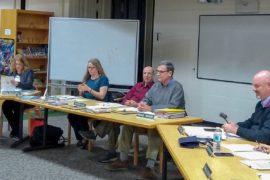Dexter is abuzz with the completion of the two Baker Rd roundabouts, also called traffic circles; circular intersections in which traffic flows almost continuously in a counter-clockwise direction around a central island.
The long-awaited end to summer road construction has come right when they said it would and now we get down to the business of collectively getting acquainted with how to effectively use them as a community. And with the beginning of school just a couple days away, keeping a few simple tips in mind will help keep us safely moving.
The idea behind a roundabout is to slow traffic but keep it moving and the improvements to traffic are expected to be:
- Compared to stop signs and traffic signals, roundabouts reduce the likelihood and severity of collisions by reducing traffic speeds and minimizing T-bone and head on collisions.
- Upon entering a roundabout, traffic only yields in one direction – left – as opposed to three directions in a standard intersection.
- The continual flow of traffic reduces queuing associated with traffic lights or stop signs with busy cross-streets.
- Vehicles spend less time idling at roundabouts than at signaled intersections potentially leading to less pollution.
- When entering vehicles only need to yield, they do not always need to perform a full stop. This results in the engine producing less work to regain speed resulting in lower emissions.
- Roundabouts allow U-turns within the normal flow of traffic.
- Slow moving traffic in roundabouts makes less noise than traffic that must stop and start, speed up and brake.
By now, we’ve probably all been through a roundabout or two – enough to be somewhat familiar with negotiating the circular intersections. Given that, there will predictably be some awkwardness and hesitancy as we all get acquainted with the new traffic pattern. Please be patient.
Here are just a few roundabout tips that may help get us all on the same page a little quicker and help (cough, cough) grease the wheels of our progress.
Slow Down: Roundabouts are designed to reduce your speed upon entry. While it may seem counter-intuitive, slowing down in a roundabout alleviates congestion. Slower speeds also make roundabouts safer than traditional intersections.
Yield, Don’t Merge: Vehicles traveling in the roundabout have the right-of-way. Do not merge into a roundabout like you merge onto a highway. Slow down and yield, or sometimes stop, for traffic that is circulating the roundabout. Enter the roundabout when a safe gap is present.
Exiting a roundabout: Use your RIGHT turn signal/indicator when exiting the roundabout. As you exit, be aware of pedestrians that may be crossing the roadway.
Worth repeating: A roundabout is a “yield-at-entry” intersection. Vehicles inside and circulating within the roundabout always have the right-of-way. Motorists and bicyclists wishing to enter the roundabout must yield to circulating traffic and wait for a safe gap to enter. This may mean motorists must completely stop at the yield sign until a safe gap is present.
Check out this 3:25 minute video of single-lane roundabout tips:









